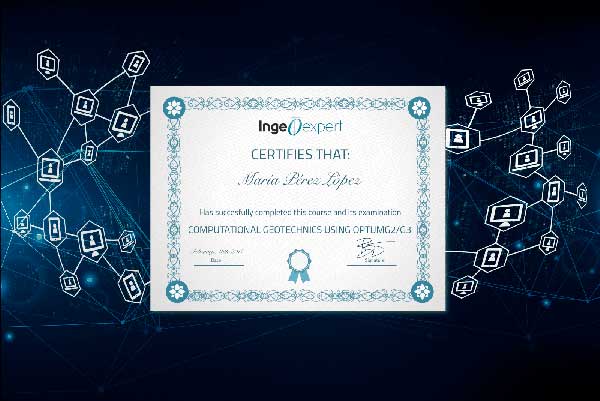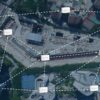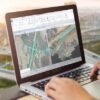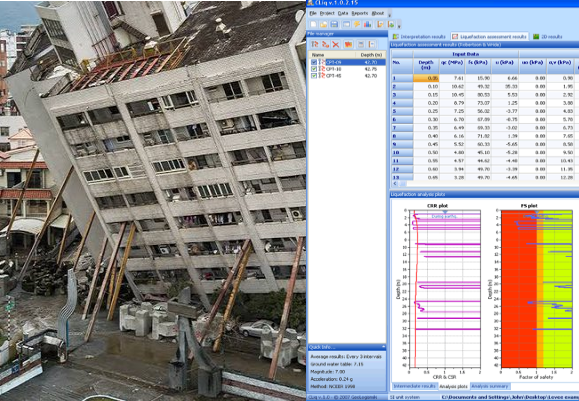Soil liquefaction: applied engineering principles and practical use of CLiq and LiqSVs software for analysis
Online course |
|
65 hours / 9 weeks |
|
To be determined |
Full-featured versions of CLiq v.3.0 (CPT soil liquefaction software) and LiqSVs 2.0 (SPT & Vs liquefaction analysis software) included for one year
Introduction
Since the 6th of February 2023, several strong earthquakes have shaken Turkey and Syria, followed by thousands of smaller aftershocks with a death toll of over 50,000 people and direct physical economic damage of up to US$ 100 billion. An initial assessment using Remote Sensing technology shows widespread seismic soil liquefaction and lateral spreading due to the earthquakes. The total area significantly affected by seismic soil liquefaction and its consequences is assessed by USGS to be about 1,000 km2, close to the area of the country Hong Kong and larger than 3 times the area of country Malta. On the other hand, an assessment by LIQUEFACT Project indicates that soil liquefaction has been directly responsible for about 50% of the earthquake-induced damage in Europe, with a value of about 15 billion Euros only in the past decade.
Seismic liquefaction of soils due to earthquake and its consequences including ground settlement, tilting and collapse of buildings due to loss of ground bearing capacity, lateral spreading and Flow failure, landslides, debris flow, fire, and failure of slopes and earthfill dams, and levees (flood protection stop banks) leading to flooding are important types of geohazards and occur in many countries causing minor to extensive damage to infrastructure, buildings, underground and aboveground lifelines like water and gas pipelines, sewerage networks and power transmission systems.
Liquefaction has been observed in earthquakes for many years. However, the Niigata earthquake in Japan and the Alaska earthquake both in 1964, brought the liquefaction phenomenon and its devastating effects to the attention of engineers, geologists, and seismologists. In fact, it is a young field in engineering and is advancing quickly with many research projects being performed all over the world and observations made in real earthquakes.
This online course initially starts by providing the participants with a sound understanding of the engineering principles and latest advances in liquefaction and lateral spreading phenomena and their engineering aspects. However, the main focus of the course will be on the practical training of participants for the analysis of liquefaction and lateral spreading using simple empirical and semi-empirical methods and the very well-known commercial software CLiq and LiqSVs that use CPT and SPT tests data performed at the site of interest.
Throughout the course and for a long period after the course, the participants will have access to fully functional licenses of both software, and the opportunity to practice their newly acquired or updated knowledge of liquefaction phenomena with hands-on exercises including examples from real sites and earthquakes.
Objectives
This online course is carefully designed to provide engineering professionals, researchers, and university students in the fields of geotechnical, civil, structural, and earthquake engineering, geology, and engineering geology with the most updated liquefaction engineering knowledge and practical capability to analyze the liquefaction potential in different soils, sites, and earthquake conditions, and related free-field settlements, lateral spreading and settlement of buildings using CPT and SPT test data and practical application of CLiq and LiqVs software for this purpose.
Although most software come with manuals and Help for users, these documents are sometimes not comprehensive and updated and don’t cover all of the limitations of the software and also the limitations of the different methods the software uses for the analysis. Using geotechnical engineering software without being well aware of their limitations, specifically for seismic soil liquefaction and lateral spreading analysis which is naturally a highly complex task can be quite misleading and sometimes disastrous. Therefore, this course, after providing the general updated knowledge on the topic and common practice in using the software, will not suffice to explain the user manuals of CLiq and LiqSVs software, but will specifically focus on clarifying the less noticed but extremely important points in using the software not mentioned in their manuals. These include their limitations and dilemmas, tricks and methods to use the software correctly and reliably, as well as the methods for sanity-checking of the software results.
The main objective of the course is to train the participants to become specialists in the practical and realistic analysis of liquefaction, settlements, and lateral spreading by using correctly and effectively CLiq and LiqVs software. In this course, the instructor not only shows you the right way to understand the liquefaction phenomena and use the software but also gets your hand and comes with you step-by-step.
INTRODUCTION. Course Outline (Free 2 hours live lecture)
- Week 1
- Instructor Introduction
- History and Importance of Liquefaction of Soils and its Consequences
- Course Introduction and Structure
- Course Goals
- Job Prospects
- Introducing Reference Documents
- Open Discussion
MODULE 1. Engineering Fundamentals of Soil Liquefaction Phenomena and Its Consequences
- Week 1
- Definitions and Concepts
- Seismic Liquefaction of Non-cohesive Soils
- Cyclic Softening of Cohesive Soils
- Parameters affecting soil liquefaction potential
- Soil Composition and Geotechnical Properties
- Earthquake Shaking Parameters
- Site Characteristics and Groundwater
- Regions in the World Most Susceptible to Seismic Liquefaction
- Week 2
- Overview of Consequences of Liquefaction
- Lateral Spreading and Its Consequences
- Liquefaction-Induced Flow Failure
- An Overview of the Effect of Liquefaction on Undrained Residual Shear Strength of Soil
- Slopes Instability
- Sources of Uncertainty in Liquefaction and lateral Spreading Analysis
- Methods to Reduce the Uncertainties
- Week 3
- Different Methods and Levels For Liquefaction Analysis
- Empirical and Semi-empirical Methods for Liquefaction Assessment
- Practical Application of Semi-empirical Methods in Assessment of Liquefaction Potential
- Worked Examples and Practicing Hand Calculation Methods
MODULE 2. Practical Application of CLiq Software for Liquefaction Analysis Using In-Situ CPT Test Data
- Week 4
- Review of CPT In-situ Geotechnical Testing and Data
- Introduction to CLiq Software, Its Principles, and Structure
- Selection of Suitable Earthquake Parameters for Liquefaction and Lateral Spreading Analysis
- Week 5
- Defining a New Project and Importing CPT Site Data into CLiq
- Defining Analysis Properties, Methods, and Parameters
- Performing Analysis and Interpretation of Results
- Week 6
- Comparison of Different Analysis Methods
- Parametric Analysis
- Assessment of Free-field Settlement, Buildings Settlement, and Lateral Spreading
- Probabilistic Analysis
- Preliminary Design of Ground Improvement using CLiq
- Comparisons of CLiq Results with The Observed behavior of Ground in Past Earthquakes
- Understanding and Exporting Analysis Results to a Report
- Worked Examples and Practicing CLiq
MODULE 3. Practical Application of LiqSVs Software for Liquefaction Analysis Using In-Situ SPT Test Data
- Week 7
- Review of SPT Geotechnical In-situ Test and Data (NSPT)
- Introduction to LiqSVs Software, Its Principles, and Structure
- Selection of Suitable Parameters for Earthquake Shaking
- Defining a New Project and Importing and Entering Site Data into LiqSVs
- Week 8
- Selection of Analysis Methods and Properties
- Performing Analysis and Interpretation of Results
- Assessment of Results of Different Analysis Methods
- Parametric Analysis
- Assessment of Free-field Settlement, Buildings Settlement, and Lateral Spreading
- Worked Examples and Practicing LiqSVs
- Week 9
- Answering Student Questions
- Open Discussion
- Final Examination
Farzad Dadfar
Farzad Dadfar is a Senior Chartered (Licensed) Civil and Geotechnical Engineer and university lecturer with a bachelor’s degree in Civil Engineering and a master’s degree in Geotechnical Engineering and over 25 years of hands-on experience in structural and geotechnical engineering in highly reputable Australian, Swiss, French, Italian, New Zealander, and Iranian engineering consultants, clients, and EPC contractors in projects from New Zealand, Australia, Oman, Thailand, Cambodia, and Iran.
He has been working on geotechnical investigations and studies, analysis and design, construction design, site supervision, inspection, and project management on different project types including geohazards and problematic soils (liquefaction and lateral spreading, landslide, rockfall, soft, organic, dispersive and expansive soils, …), superstructure and foundation design for small to high-rise buildings, land development and subdivision for new cities and earthworks, transportation infrastructures (roads, bridges, tunnels, underground rail-Metro), stormwater and flood protection dams and stop banks, drinking water treatment sites and distribution networks, and wastewater collection networks and treatment sites, irrigation and drainage networks, different types of dams including concrete and embankment dams up to 205 m high, hydropower schemes, river training and erosion control, deep excavations and ground improvement from conception to commissioning.
He is highly proficient in geotechnical analysis and design using hand calculations, basic software (e.g. CLiq, LiqSVs, LiquefyPro, CPeT-IT, SLIDE2, Rocfall2, Wallap, PROKON, …), and Finite Element Method (FEM) by software including PLAXIS and GeoStudio for highly sophisticated coupled stress-deformation-seepage and Acceleration Time-History seismic analysis.
Following his graduation from university in 2000, he joined Azad University in Iran, lecturing civil, geotechnical, and structural courses to students of different levels. He has also been the Official Lecturer of Iran’s Civil Engineering Organization to provide geotechnical and structural courses for Chartered Engineers wishing to upgrade to higher levels of Chartership. He has also provided numerous short courses for engineering consultant companies’ experts and has been actively mentoring his younger colleagues in consultants and contractors.
The course is delivered online through our easy-to-use Virtual Campus platform. For this course, a variety of content is provided including:
– eLearning materials
– Videos
– Interactive multimedia content
– Live webinar classes
– Texts and technical articles
– Case studies
– Assignments and evaluation exercises
Students can download the materials and work through the course at their own pace. We regularly update this course to ensure the latest news and state-of-the-art developments are covered, and your knowledge of the subject is current.
Live webinars form part of our course delivery. These allow students and tutors to go through the course materials, exchange ideas and knowledge, and solve problems together in a virtual classroom setting. Students can also make use of the platform’s forum, a meeting point to interact with tutors and other students.
The tutoring system is managed by email. Students can email the tutor with any questions about the course and the tutor will be happy to help.
All professionals including civil, geotechnical, and earthquake engineers, geologists, engineering geologists, seismologists, related university students, and researchers, wishing to learn or upgrade their scientific and engineering knowledge of soil liquefaction and its consequences, and practically use CLiq and LiqSVs software for analysis of liquefaction, and liquefaction-induced lateral spreading, settlements of the ground, and settlements of structures on the liquefied ground can benefit from this course substantially.
The main pre-requisite for this course would be a sound knowledge of Soil Mechanics. Having an understanding of the principles of Soil Dynamics, Earthquake Engineering and Geology is highly recommended.
Once a student finishes the course and successfully completes the assignments and evaluation tests, they are sent an accreditation certificate. The certificate is issued by Ingeoexpert to verify that the student has passed the course. It is a digital certificate that is unique and tamper-proof – it is protected by Blockchain technology. This means it is possible for anyone to check that it is an authentic, original document.
You will be able to download the certificate in an electronic format from the virtual campus platform. The certificate can be forwarded by email, shared on social networks, and embedded on websites. To see an example, click here.
The practical approach of this course enables experienced and younger engineers and engineering students to increase their chances to secure a better job or a higher position in the job market, especially in regions and countries where soil liquefaction and its consequences are major geohazards, and specialists in this field are highly in demand.
Also, university students and researchers will find this course highly beneficial for success in their research, including in preparation of their dissertations, thesis and papers.
Full-featured versions of CLiq v.3.0 (CPT soil liquefaction software) and LiqSVs 2.0 (SPT & Vs liquefaction analysis software) included for one year
Introduction
Since the 6th of February 2023, several strong earthquakes have shaken Turkey and Syria, followed by thousands of smaller aftershocks with a death toll of over 50,000 people and direct physical economic damage of up to US$ 100 billion. An initial assessment using Remote Sensing technology shows widespread seismic soil liquefaction and lateral spreading due to the earthquakes. The total area significantly affected by seismic soil liquefaction and its consequences is assessed by USGS to be about 1,000 km2, close to the area of the country Hong Kong and larger than 3 times the area of country Malta. On the other hand, an assessment by LIQUEFACT Project indicates that soil liquefaction has been directly responsible for about 50% of the earthquake-induced damage in Europe, with a value of about 15 billion Euros only in the past decade.
Seismic liquefaction of soils due to earthquake and its consequences including ground settlement, tilting and collapse of buildings due to loss of ground bearing capacity, lateral spreading and Flow failure, landslides, debris flow, fire, and failure of slopes and earthfill dams, and levees (flood protection stop banks) leading to flooding are important types of geohazards and occur in many countries causing minor to extensive damage to infrastructure, buildings, underground and aboveground lifelines like water and gas pipelines, sewerage networks and power transmission systems.
Liquefaction has been observed in earthquakes for many years. However, the Niigata earthquake in Japan and the Alaska earthquake both in 1964, brought the liquefaction phenomenon and its devastating effects to the attention of engineers, geologists, and seismologists. In fact, it is a young field in engineering and is advancing quickly with many research projects being performed all over the world and observations made in real earthquakes.
This online course initially starts by providing the participants with a sound understanding of the engineering principles and latest advances in liquefaction and lateral spreading phenomena and their engineering aspects. However, the main focus of the course will be on the practical training of participants for the analysis of liquefaction and lateral spreading using simple empirical and semi-empirical methods and the very well-known commercial software CLiq and LiqSVs that use CPT and SPT tests data performed at the site of interest.
Throughout the course and for a long period after the course, the participants will have access to fully functional licenses of both software, and the opportunity to practice their newly acquired or updated knowledge of liquefaction phenomena with hands-on exercises including examples from real sites and earthquakes.
Objectives
This online course is carefully designed to provide engineering professionals, researchers, and university students in the fields of geotechnical, civil, structural, and earthquake engineering, geology, and engineering geology with the most updated liquefaction engineering knowledge and practical capability to analyze the liquefaction potential in different soils, sites, and earthquake conditions, and related free-field settlements, lateral spreading and settlement of buildings using CPT and SPT test data and practical application of CLiq and LiqVs software for this purpose.
Although most software come with manuals and Help for users, these documents are sometimes not comprehensive and updated and don’t cover all of the limitations of the software and also the limitations of the different methods the software uses for the analysis. Using geotechnical engineering software without being well aware of their limitations, specifically for seismic soil liquefaction and lateral spreading analysis which is naturally a highly complex task can be quite misleading and sometimes disastrous. Therefore, this course, after providing the general updated knowledge on the topic and common practice in using the software, will not suffice to explain the user manuals of CLiq and LiqSVs software, but will specifically focus on clarifying the less noticed but extremely important points in using the software not mentioned in their manuals. These include their limitations and dilemmas, tricks and methods to use the software correctly and reliably, as well as the methods for sanity-checking of the software results.
The main objective of the course is to train the participants to become specialists in the practical and realistic analysis of liquefaction, settlements, and lateral spreading by using correctly and effectively CLiq and LiqVs software. In this course, the instructor not only shows you the right way to understand the liquefaction phenomena and use the software but also gets your hand and comes with you step-by-step.
INTRODUCTION. Course Outline (Free 2 hours live lecture)
- Week 1
- Instructor Introduction
- History and Importance of Liquefaction of Soils and its Consequences
- Course Introduction and Structure
- Course Goals
- Job Prospects
- Introducing Reference Documents
- Open Discussion
MODULE 1. Engineering Fundamentals of Soil Liquefaction Phenomena and Its Consequences
- Week 1
- Definitions and Concepts
- Seismic Liquefaction of Non-cohesive Soils
- Cyclic Softening of Cohesive Soils
- Parameters affecting soil liquefaction potential
- Soil Composition and Geotechnical Properties
- Earthquake Shaking Parameters
- Site Characteristics and Groundwater
- Regions in the World Most Susceptible to Seismic Liquefaction
- Week 2
- Overview of Consequences of Liquefaction
- Lateral Spreading and Its Consequences
- Liquefaction-Induced Flow Failure
- An Overview of the Effect of Liquefaction on Undrained Residual Shear Strength of Soil
- Slopes Instability
- Sources of Uncertainty in Liquefaction and lateral Spreading Analysis
- Methods to Reduce the Uncertainties
- Week 3
- Different Methods and Levels For Liquefaction Analysis
- Empirical and Semi-empirical Methods for Liquefaction Assessment
- Practical Application of Semi-empirical Methods in Assessment of Liquefaction Potential
- Worked Examples and Practicing Hand Calculation Methods
MODULE 2. Practical Application of CLiq Software for Liquefaction Analysis Using In-Situ CPT Test Data
- Week 4
- Review of CPT In-situ Geotechnical Testing and Data
- Introduction to CLiq Software, Its Principles, and Structure
- Selection of Suitable Earthquake Parameters for Liquefaction and Lateral Spreading Analysis
- Week 5
- Defining a New Project and Importing CPT Site Data into CLiq
- Defining Analysis Properties, Methods, and Parameters
- Performing Analysis and Interpretation of Results
- Week 6
- Comparison of Different Analysis Methods
- Parametric Analysis
- Assessment of Free-field Settlement, Buildings Settlement, and Lateral Spreading
- Probabilistic Analysis
- Preliminary Design of Ground Improvement using CLiq
- Comparisons of CLiq Results with The Observed behavior of Ground in Past Earthquakes
- Understanding and Exporting Analysis Results to a Report
- Worked Examples and Practicing CLiq
MODULE 3. Practical Application of LiqSVs Software for Liquefaction Analysis Using In-Situ SPT Test Data
- Week 7
- Review of SPT Geotechnical In-situ Test and Data (NSPT)
- Introduction to LiqSVs Software, Its Principles, and Structure
- Selection of Suitable Parameters for Earthquake Shaking
- Defining a New Project and Importing and Entering Site Data into LiqSVs
- Week 8
- Selection of Analysis Methods and Properties
- Performing Analysis and Interpretation of Results
- Assessment of Results of Different Analysis Methods
- Parametric Analysis
- Assessment of Free-field Settlement, Buildings Settlement, and Lateral Spreading
- Worked Examples and Practicing LiqSVs
- Week 9
- Answering Student Questions
- Open Discussion
- Final Examination
Farzad Dadfar
Farzad Dadfar is a Senior Chartered (Licensed) Civil and Geotechnical Engineer and university lecturer with a bachelor’s degree in Civil Engineering and a master’s degree in Geotechnical Engineering and over 25 years of hands-on experience in structural and geotechnical engineering in highly reputable Australian, Swiss, French, Italian, New Zealander, and Iranian engineering consultants, clients, and EPC contractors in projects from New Zealand, Australia, Oman, Thailand, Cambodia, and Iran.
He has been working on geotechnical investigations and studies, analysis and design, construction design, site supervision, inspection, and project management on different project types including geohazards and problematic soils (liquefaction and lateral spreading, landslide, rockfall, soft, organic, dispersive and expansive soils, …), superstructure and foundation design for small to high-rise buildings, land development and subdivision for new cities and earthworks, transportation infrastructures (roads, bridges, tunnels, underground rail-Metro), stormwater and flood protection dams and stop banks, drinking water treatment sites and distribution networks, and wastewater collection networks and treatment sites, irrigation and drainage networks, different types of dams including concrete and embankment dams up to 205 m high, hydropower schemes, river training and erosion control, deep excavations and ground improvement from conception to commissioning.
He is highly proficient in geotechnical analysis and design using hand calculations, basic software (e.g. CLiq, LiqSVs, LiquefyPro, CPeT-IT, SLIDE2, Rocfall2, Wallap, PROKON, …), and Finite Element Method (FEM) by software including PLAXIS and GeoStudio for highly sophisticated coupled stress-deformation-seepage and Acceleration Time-History seismic analysis.
Following his graduation from university in 2000, he joined Azad University in Iran, lecturing civil, geotechnical, and structural courses to students of different levels. He has also been the Official Lecturer of Iran’s Civil Engineering Organization to provide geotechnical and structural courses for Chartered Engineers wishing to upgrade to higher levels of Chartership. He has also provided numerous short courses for engineering consultant companies’ experts and has been actively mentoring his younger colleagues in consultants and contractors.
The course is delivered online through our easy-to-use Virtual Campus platform. For this course, a variety of content is provided including:
– eLearning materials
– Videos
– Interactive multimedia content
– Live webinar classes
– Texts and technical articles
– Case studies
– Assignments and evaluation exercises
Students can download the materials and work through the course at their own pace. We regularly update this course to ensure the latest news and state-of-the-art developments are covered, and your knowledge of the subject is current.
Live webinars form part of our course delivery. These allow students and tutors to go through the course materials, exchange ideas and knowledge, and solve problems together in a virtual classroom setting. Students can also make use of the platform’s forum, a meeting point to interact with tutors and other students.
The tutoring system is managed by email. Students can email the tutor with any questions about the course and the tutor will be happy to help.
All professionals including civil, geotechnical, and earthquake engineers, geologists, engineering geologists, seismologists, related university students, and researchers, wishing to learn or upgrade their scientific and engineering knowledge of soil liquefaction and its consequences, and practically use CLiq and LiqSVs software for analysis of liquefaction, and liquefaction-induced lateral spreading, settlements of the ground, and settlements of structures on the liquefied ground can benefit from this course substantially.
The main pre-requisite for this course would be a sound knowledge of Soil Mechanics. Having an understanding of the principles of Soil Dynamics, Earthquake Engineering and Geology is highly recommended.
Once a student finishes the course and successfully completes the assignments and evaluation tests, they are sent an accreditation certificate. The certificate is issued by Ingeoexpert to verify that the student has passed the course. It is a digital certificate that is unique and tamper-proof – it is protected by Blockchain technology. This means it is possible for anyone to check that it is an authentic, original document.
You will be able to download the certificate in an electronic format from the virtual campus platform. The certificate can be forwarded by email, shared on social networks, and embedded on websites. To see an example, click here.
The practical approach of this course enables experienced and younger engineers and engineering students to increase their chances to secure a better job or a higher position in the job market, especially in regions and countries where soil liquefaction and its consequences are major geohazards, and specialists in this field are highly in demand.
Also, university students and researchers will find this course highly beneficial for success in their research, including in preparation of their dissertations, thesis and papers.
More info
Finish this course and get a certificate based on Blockchain
Soil liquefaction: applied engineering principles and practical use of CLiq and LiqSVs software for analysis

Blockchain technology makes the certificate incorruptible, enabling companies to verifiy its autenticity.





Reviews
There are no reviews yet.